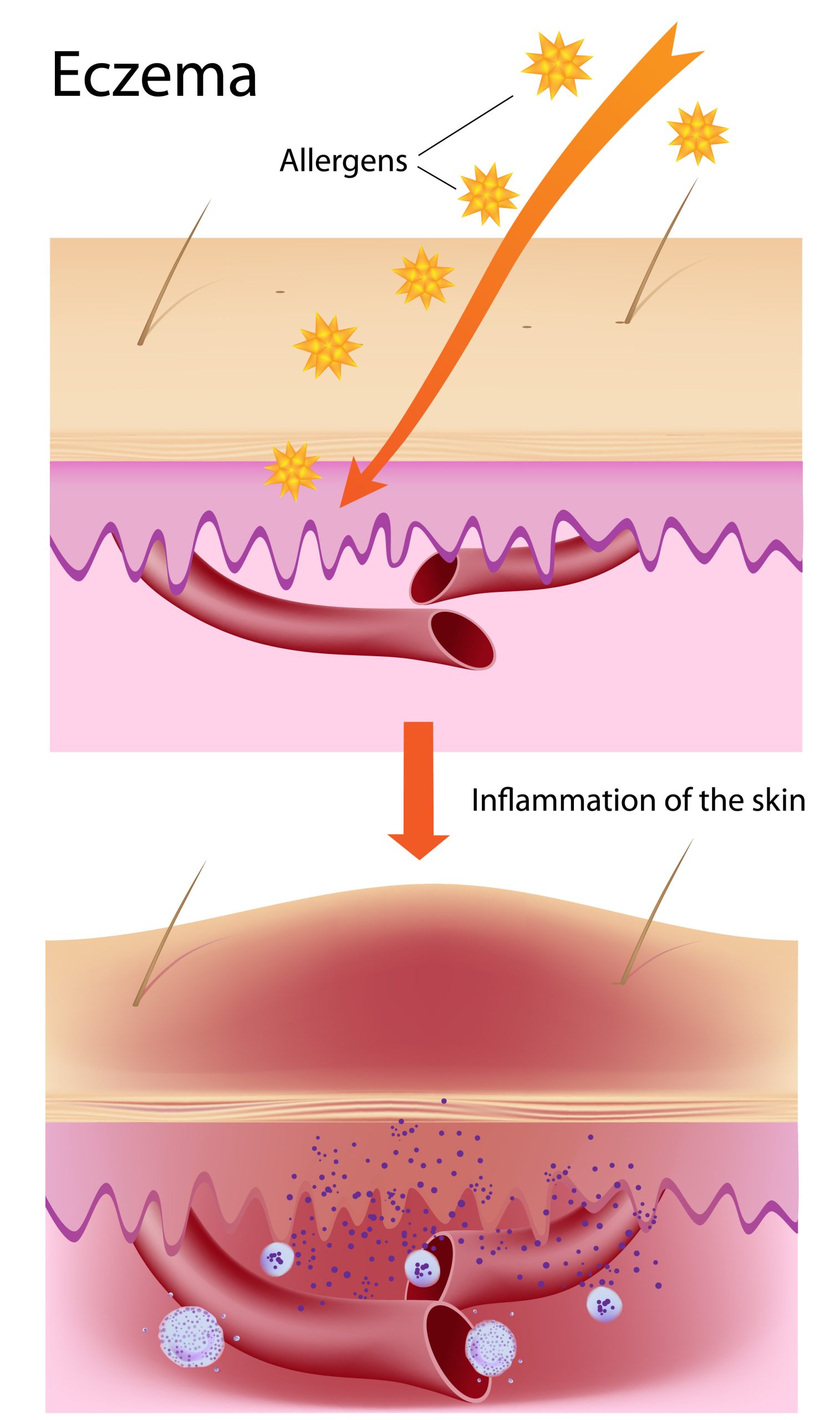Eczema, also known as atopic dermatitis, is a common skin condition that affects a significant number of children globally. In the UK alone, it’s estimated that at least one in every five children is affected. The condition is characterized by dry, itchy, red, and cracked skin, and while it primarily affects children, it can persist into adulthood.
Pathophysiology of Eczema
Eczema is an inflammatory skin condition. The exact cause remains unknown, but it’s generally accepted that it arises from a combination of genetic factors and environmental triggers.
One of the key genetic factors is a mutation in the FLG gene, which encodes the protein filaggrin. Filaggrin plays a crucial role in maintaining the skin’s barrier function. A mutation in this gene can lead to a compromised skin barrier, making the skin more susceptible to dryness and irritation. This compromised skin barrier can also make the skin more open to allergens and irritants, triggering the release of chemicals that make the skin itchy.
Environmental triggers can include soaps and shampoos, hard water, and central heating, all of which can cause increased dryness of the skin. These factors can exacerbate the symptoms of eczema, leading to more severe outbreaks.
Link to Asthma Gene
Research suggests that there is a link between eczema and asthma. In around 50% of people with eczema, the FLG gene has a mutation in its DNA sequence that causes it to instruct cells to make less filaggrin. This compromises the skin’s epidermis, leading to dry, uncomfortable skin that is prone to infection and allergic reactions. People with anomalies in FLG are also prone to asthma and hay fever.
Locations of Eczema in Different Age Groups
Eczema can affect any area of the skin, but the severity of symptoms and areas affected can vary with age. In infants younger than 1 year old, eczema usually appears on their cheeks, forehead, or scalp. It may spread to the knees, elbows, and trunk (but not usually the diaper area).
Toddlers and preschoolers often have patchy eczema on their wrists, elbows, ankles and knees. As children grow older into their teenage years, the rash typically appears in the bends of the elbows, behind the knees, on the neck, or on the inner wrists and ankles.
Prevalence in Infants and Children
Eczema is quite common among infants and children. It’s estimated that around 20% of children under two years of age have eczema. The condition usually starts in the first six months of life.
As for older children, about 6% of children and adolescents currently have eczema symptoms. However, these figures can vary as eczema prevalence has been observed to increase over the past decade in these age groups.
Management of Eczema
While there is no cure for eczema currently available, its symptoms can be effectively managed with appropriate treatment and by avoiding aggravating factors. Emollients are needed to soften and moisturise the skin while steroid creams are used to reduce inflammation. Special bath creams that add moisture to the skin should be used instead of traditional bubble bath or soap.
For more information on how to apply emollients in paediatric eczema effectively, check out this guide on Understanding and Applying Emollients in Paediatric Eczema.
If properly managed in early childhood, eczema can be cleared or well controlled with minimal need for ongoing treatment. However, it’s advisable for individuals with a history of eczema to continue treating their skin as delicate and avoid potential irritants such as perfumed body sprays, deodorants, soaps, face wipes and body washes.
References:
Drucker, A.M., 2023. Atopic dermatitis in 2023 and beyondBritish Journal of Dermatology, 188(6), pp.691-6921.
Ferrucci, S.M., Tavecchio, S., Marzano, A.V., Buffon, S., 2023. Emerging Systemic Treatments for Atopic DermatitisDermatology and Therapy, 13, pp.1071-10812.
Australasian Society of Clinical Immunology and Allergy (ASCIA), 2023. Eczema – Australasian Society of Clinical Immunology and Allergy (ASCIA)3.
Liu, W., Cai, J., Sun, C., Zou, Z., Zhang, J., Huang, C., 2022. Time-trends for eczema prevalences among children and adults from 1985 to 2015 in China: a systematic review BMC Public Health, 22(1), p.12944.
Yosipovitch, G., 2023. Trends in the Prevalence of Eczema Among US Children by Age, Sex, Race, and Ethnicity From 1997 to 2018JAMA Dermatology, 159(4), pp.454–4565.






